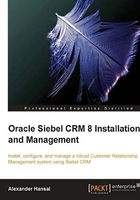
The Siebel web architecture
In order to allow thousands of users access to critical enterprise data over the web channel, Siebel CRM is based on a typical web architecture. This architecture allows for great scalability and platform compatibility and has been under development for more than a decade.
Note
In 2001, Siebel released version 7.0 of its CRM suite. This was the first version that was completely web-based. Prior versions (like Siebel 2000) were based on the client-server architecture, which was typical for enterprise applications in the 90s.
However, Siebel 7.0 was not the first version that allowed access to data and functionality from a web browser. Applications like Siebel eService or Siebel eSales were available in earlier versions and the Siebel web architecture as we see it today had its origin in these first customer facing web applications.
The Siebel web architecture consists of the following main building blocks:
- A relational database to store customer, administrative, and repository data
- A shared directory structure to store binary, non-relational information such as attachment documents and temporary files
- One or more Siebel Servers, which are grouped together in a Siebel Enterprise server
- The Siebel Gateway Name Server to manage and store the enterprise configuration
- A web server
- The Siebel Web Server Extension (SWSE), installed on the web server
- A web browser to display the graphical user interface
Let us bring these building blocks together in a diagram:
The diagram above depicts the Siebel Web Architecture. In the following section, we will discuss each of the major building blocks in detail.
